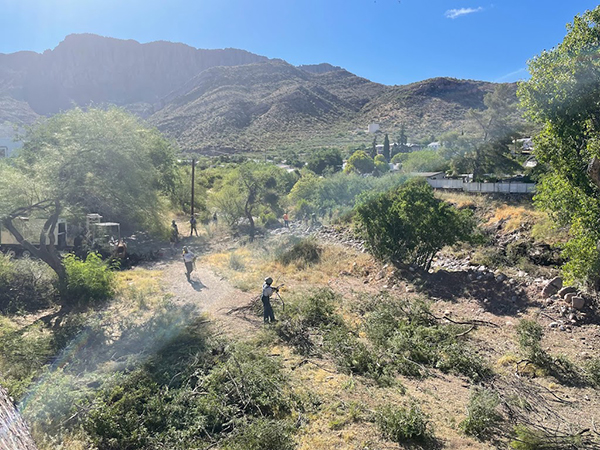Bringing a Flowing Stream Back to Superior

More than twenty-five years ago—1998, to be exact—the mayor of Superior, a mining town sixty-five miles from Phoenix, and the Gila County manager were talking over a couple of beers. Not too far from where they were sitting was Queen Creek, a stream whose flow had slowed to a trickle. As the story goes, one of them looked at his Coors can—embossed with animated mountains and streams—and said, ‘Why can’t that be us?’ So, they commissioned a study of how to get the creek flowing again into Superior.
Not much happened after that initial study, mostly thanks to funding challenges. When Superior Town Manager Todd Pryor took the job in 2016, though, he helped give the 1998 study new life and pulled some of its better ideas. But as Pryor explained, small towns like Superior—with a population of three thousand—typically don’t have the administrative makeup to raise the amount of money that was needed.
Enter the Infrastructure Investment and Jobs Act (IIJA)—signed into law in November of 2021—and its more than tenfold expansion of the U.S. Army Corps of Engineers’ Environmental Infrastructure program (EI). Superior won a two point two five-million-dollar grant via EI to help restore Queen Creek and get the water flowing past fractures and fissures that have diverted the water out of the stream near a shuttered mine. This diversion of water resulted in a decline in the natural riparian habitat that supports diverse plant and animal life around waterways.
“The big project—the Army Corps project—takes water from an old infiltration gallery in the creek that used to provide drinking water,” Pryor says. “It pipes it past all those fracture zones, and it drops it back into town. And it takes another amount of water from our wastewater treatment plant and pumps it through the bottom of town and puts it into a park in the center of town.”
Superior is among many communities in Arizona that release treated or “reclaimed” wastewater back into natural waterways to provide environmental and community benefits. Tucson, Phoenix, Buckeye, Flagstaff, and other communities do the same, but in recent years, this water has been targeted for other uses, and little by little may be removed from these rivers. Pryor is optimistic about the impact the project will have on the community—improving the quality of life for human residents and the more natural inhabitants.

“Restoring the base flow will restore the shallow groundwater aquifer, which will allow the riparian area to recover. Number one goal for this is riparian area help,” Pryor explains. “Getting those trees trimmed out, getting the canopy developed. It helps with fire protection and climate change mitigation because you’re creating shade and moisture on the surface, which will help alleviate heat issues and stop heat islands.”
In 2021, the Telegraph Fire became the sixth-largest wildfire in Arizona history, charring more than one hundred seventy thousand acres. One of Superior’s popular tourist destinations—the Boyce Thompson Arboretum—narrowly escaped being damaged by the fire. Mayor Mila Besich says the fire’s proximity provided even more incentive to restore Queen Creek.
“The arboretum is a beautiful place, but we know that in order to protect it, we have to improve water infrastructure there, with modern fire hydrants to protect these collections,” Besich explained. “In some cases, we’re the only place anymore where some of these plants exist or are being cared for because of climate change.”
The damage from the Telegraph Fire is also at the front of Jim Schenck’s mind. Schenck is the Vice President of Legends of Superior Trails and Treasurer for Rebuild Superior.
“If you look at risks for towns like ours, the number one risk is wildfire. We’re trying to be very proactive,” Schenck says. “An increased riparian area and water in the creek is a natural protection for the town.”
Schenck also expects Queen Creek restoration to be a boon for tourism in the area.
“One of the things with Superior is, technically, we are still a depressed mining town on the way back,” Schenck continues. “We are situating ourselves as a premier outdoor destination. So, it has an economic development component, but it also has the whole quality of life thing.”
Mayor Besich, who grew up in Superior when her father was vice mayor, says the restoration project is an example of the community being responsible water stewards. She anticipates the effort will lead to a greater commitment to green infrastructure for her daughter and subsequent generations.
“We’re all responsible for looking at our environmental health in our communities,” Besich says. “I’m proud of the work that our team has done here to move these projects forward in a rapid situation for a very small town.”
Town Manager Todd Pryor is also focused on the creek’s future—and how he hopes it will resemble the past.
“We’re trying to restore part of the damages that have been created in 100 years of use of this land,” Pryor explains. “We’re not going to get it all the way back, but we’re going to restore part of the health at least so it’s more sustainable.”
Finding that balance and helping Queen Creek stay healthy is a significant part of putting Superior on track to thrive for years to come. Thanks to the leadership of Pryor, Mayor Besich and other leaders, and the investment of funds from the IIJA, Superior’s Queen Creek will once again bring water through the town and see a decade’s old vision become a reality.
